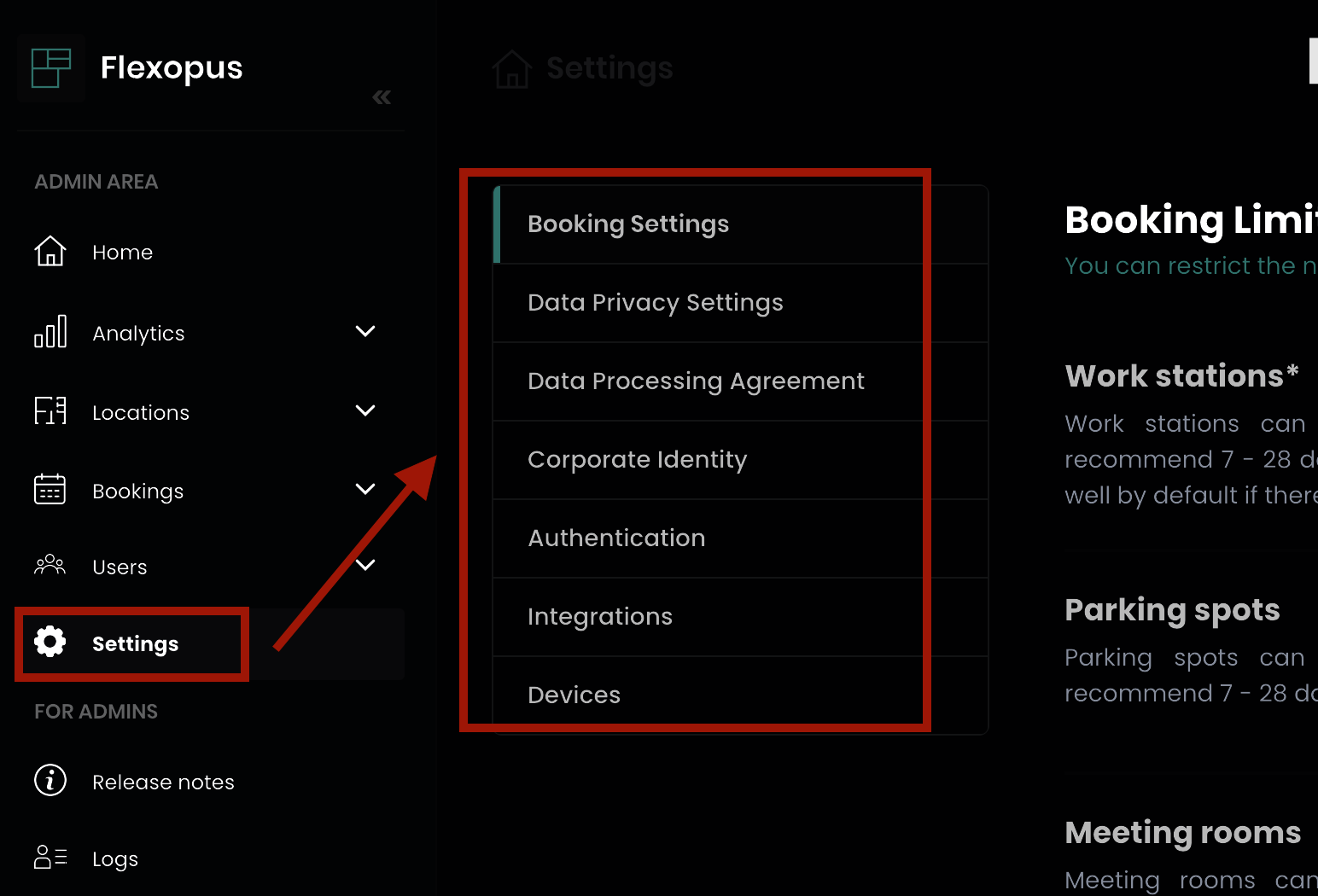In the "Settings" you can define or change company-wide settings.
In this article, read about the settings you can make as an admin:
Authentication / Integrations and

The settings are divided into different areas. The options within the different areas are explained in more detail below. You confirm your adjustments by clicking on "Save" at the bottom right.
Booking Setting
- Booking Limits: Here you define the time range within which your users can book seats and resources in advance and whether weekends should be skipped for future booking limits.
- Past Bookings: Here you set whether users can see previous bookings on the live schedule. Here you can also set the limit of days.
- Booking Conflict Check: By default, users are only allowed to have a maximum of one booking of each object type (workstation, meeting room, parking space) in parallel. Here you can allow objects of the type meeting room to have multiple bookings at the same time.
- Booking Time Range: This allows you to set a default start and end time for the booking. You can also adjust times for the earliest and latest possible booking time to match your company's working hours.
- Recurring Bookings: Here you can allow recurring bookings for normal users. However, we do not recommend this, as otherwise fixed seat structures may emerge again.
-
Home Office: As an administrator, you can activate Home Office for selected user groups in your organisation. The selected users can then create home office bookings. Home office must not overlap with a workstation or parking space booking.
- Email settings: Here you can activate the booking notifications and the sending of ICalendar events. The sending of fixed booking notifications can also be activated here and the Email footer message can be set.
- Check-In and Check-Out: If you activate this function, your users must confirm their booking by checking in and are given the option to check out. You can also set the general conditions for check-in here, such as notification emails and the check-in period.
Different time periods can be defined for different object types (workstations, meeting rooms, parking spots, homeoffice). - Visitor management: As an administrator, you can activate guest bookings here and activate booking notification to external visitors.
Data Privacy settings
-
Privacy filter for users: With Flexopus user data can be completely hidden. This way, users cannot see any information about each other. Profiles are hidden, bookings do not show names and users cannot be found via the search function. Depending on your company's wishes, various options can be applied to the privacy settings of your employees.
-
Disable user profiles: Turn off the user profiles feature completely. User data will still be visible on maps, booking pages, and in the admin area.
-
Booking anonymization: By enabling anonymization of booking data and setting a time period after it takes effect, you protect your users' personal data. You can also set company-wide privacy settings if your company requires anonymous booking for employees for privacy reasons. This feature hides user profiles, makes bookings anonymous, and prevents users from being searched.
-
Anonymize bookings after ... days: After the specified time has expired, the data is automatically anonymised. The data cannot be de-anonymised again after this time has expired.
-
Mobile application access: Access to the mobile application installed via the App Store or Play Store can be disabled here. This setting does not control whether users can install the PWA or use Flexopus from their mobile browsers.
-
Session expires on Close: If this setting is active, the session is automatically ended as soon as the user closes the browser.
-
Session Lifetime: The duration of the session can be set here.
- Archive users automatically: If this setting is active, users who have not logged in for a certain number of days are archived by the system.
- Automatically archive users after ... days: A daily limit can be set here for when inactive users should be automatically archived.
-
Delete archived users automatically: If this setting is active, archived users are automatically anonymised and permanently deleted. This also applies to users who have been automatically deactivated by external services, e.g. SCIM.
-
Automatically delete archived users after ... days: A daily limit can be set here for when archived users are to be automatically deleted.
-
Privacy policy: Here you can either use our privacy policy (use at your own risk, we are not allowed to give legal advice), which is generated automatically, or upload your own document. You can also decide whether you want to require a confirmation of consent from each user and document it.
Data Processing Agreement
- Here you can finalize and sign your data processing agreement.
Corporate Identity
- Name, logo and default language: Maintain your general organisational data, which is automatically used in the imprint, for example. You can also define the standard language for your users or individualise the title images of the booking types.
Authentication / Integrations
For SSO use, simply activate the desired service in the admin settings and enter the domain to which the login should be limited. In addition, you have the option here to manage further settings for the SSO, to set up a user synchronization via SCIM or if the module "Microsoft Exchange" is activated, then you can also set up the link here. Here you can find detailed instructions for the possible integrations.
Devices
If this additional module is activated for you, you can manage meeting room displays or other linked screens here.
R0021